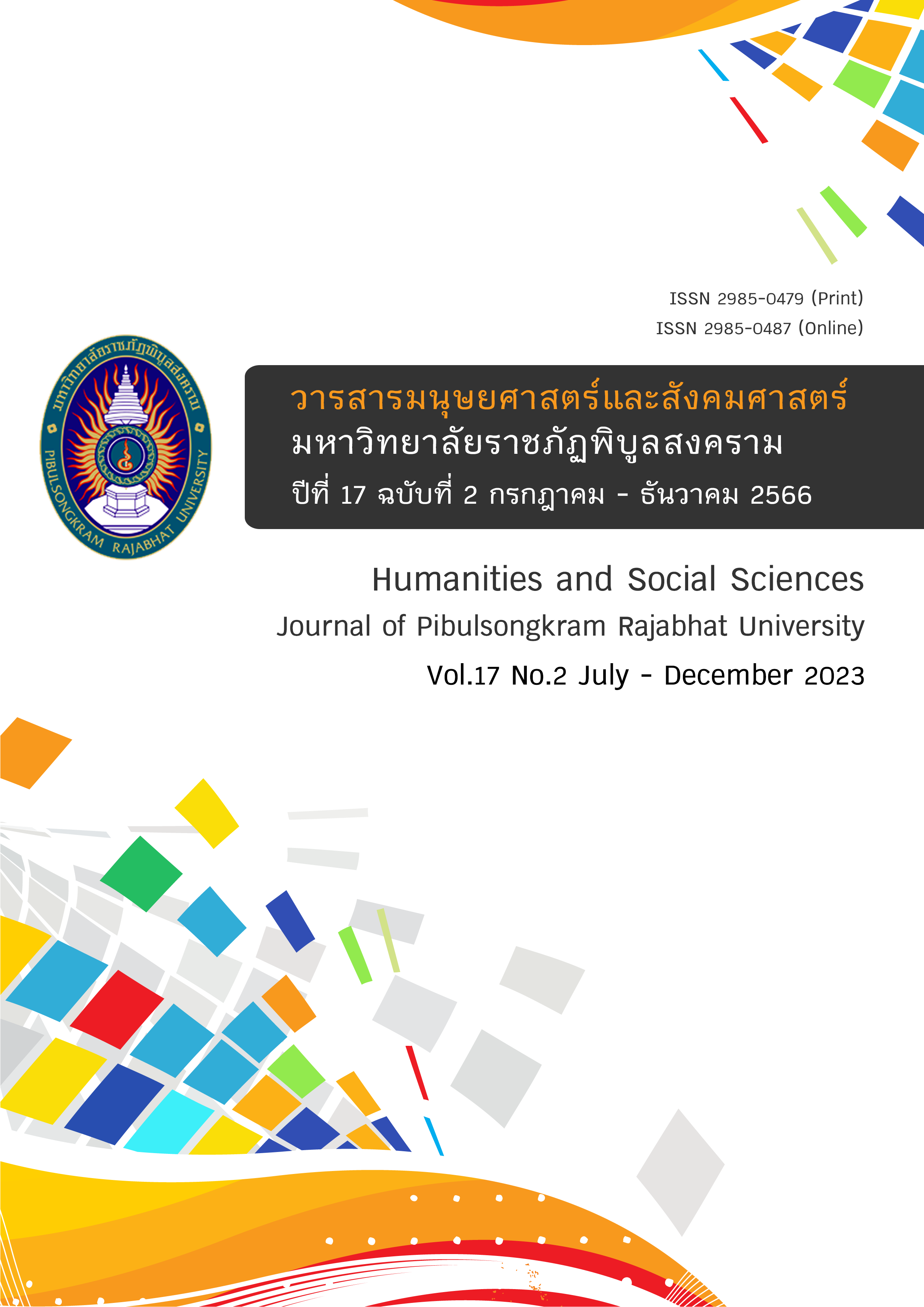Nhum Pao Keng Keawsaochao Hmong
DOI:
https://doi.org/10.14456/psruhss.2023.36Keywords:
Hmong, Keng, Thai folk danceAbstract
This research aimed at to creative Thai folk dance called Nhum Pao Keng Keaw Sao Chao Hmong. The target group used in the research consisted of 5local people, 3dramatic arts teachers, and 10students of program in dramatic arts, Loei Rajabhat University. The research was carried out with qualitative method. The findings were as followings.
- Creative of Thai folk dance called Nhum Pao Keng Keaw Sao Chao Hmong found that the executing process were divided into 5 states, including of (1) concept specification for dramatically danced set (2) define performance pattern (3) specification the acting composition (4) dancing creating and variation row (5) pretest for completed acting. This is presented in folk dance style that the researchers composed the music, and the dresses, this part of the show reveals the joyfulness portraying the relationship of men and women, the blow style of young Hmong musicians, and joyfulness in celebrate.
- Transmission and present this Thai folk dance yielded in 4 aspects; the first, dramatic concept, to apparently show the native cultural identity, the second, acting pattern presented in a joyful and fun. The third, music is conform with acting concept these meanings and suitable for dance. The fourth, the dance design comprehensive definition of content, there is a mix of both native and unique gestures, which makes it interesting.
References
คณะศิลปกรรมศาสตร์. (2545). การแสดงและการออกแบบ. กรุงเทพฯ: คณะศิลปกรรมศาสตร์ มหาวิทยาลัยศรีนครินทรวิโรฒ.
จารุณี หงส์จารุ (2558). เสียงในละคร ใน ปริทัศน์ศิลปการละคร. นพมาส แววหงส์, บรรณาธิการ. กรุงเทพฯ: ภาควิชาศิลปะการละคร คณะอักษรศาสตร์ จุฬาลงกรณ์มหาวิทยาลัย.
ฉันทนา อุดมสิน. (2531). นาฏศิลป์และการละครระดับประถมศึกษา. ขอนแก่น: คณะศึกษาศาสตร์ มหาวิทยาลัยขอนแก่น.
ฉันทนา เอี่ยมสกุล. (2554). ศิลปะการออกแบบท่ารำ (นาฏศิลป์ไทยสร้างสรรค์). กรุงเทพฯ: บพิธการพิมพ์.
บุญลอย จันทร์ทอง. (2546). ดนตรีชาวเขาเผ่าม้ง หมู่บ้านสบเป็ด อำเภอท่าวังผา จังหวัดน่าน (วิทยานิพนธ์ปริญญามหาบัณฑิต). กรุงเทพฯ: มหาวิทยาลัยศรีนคริทรวิโรฒ.
ปรานี วงษ์เทศ. (2525). พื้นบ้านพื้นเมือง. กรุงเทพฯ: โรงพิมพ์เรือนแก้วการพิมพ์.
พจน์มาลย์ สมรรคบุตร. (2538). แนวการคิดประดิษฐ์ท่ารำเซิ้ง (พิมพ์ครั้งที่ 2). อุดรธานี: มหาวิทยาลัยราชภัฏอุดรธานี.
พรเทพ บุญจันทร์เพ็ชร์. (2564). การสร้างสรรค์การแสดงชุด มันนิบาแตช. วารสารศิลปกรรมศาสตร์ มหาวิทยาลัยขอนแก่น, 13(1), 128-129.
วาสนา ร่มโพธิ์, ศุภรัตน์ ทองพานิชย์, ทูลทองใจ ซึ่งรัมย์, กฤษฎ์เตชินห์ เสกฐานโชติจินดา, และสุรเดช เนียมคำ. (2563). สะไนเกี้ยวสาว ใน การนําเสนอผลงานวิจัยสร้างสรรค์นาฏดุริยางคศิลป์ระดับชาติในงานมหกรรมศิลปวัฒนธรรมไทย ประจําปี 2563. (น.91-94) ลพบุรี: สถาบันบัณฑิตพัฒนศิลป์ กระทรวงวัฒนธรรม. สืบค้นจาก http://bpi.ac.th/images/bpi_document/Research/2020_Lopburi.pdf.
สดใส พันธุมโกมล. (2538). ศิลปะของการแสดง [ละครสมัยใหม่]. กรุงเทพฯ: จุฬาลงกรณ์มหาวิทยาลัย.
สมศักดิ์ บัวรอด. (2558). การสร้างละครรำ. กรุงเทพฯ: คณะศิลปกรรมศาสตร์ มหาวิทยาลัยราชภัฏสวนสุนันทา.
สามารถ จันทร์สูรย์. (2534). ภูมิปัญญาท้องถิ่นคืออะไร อย่างไร. ใน การสัมมานาทางวิชาการเรื่องภูมิปัญญาชาวบ้าน. กรุงเทพฯ: คุรุสภาลาดพร้าว.
สุรพล วิรุฬห์รักษ์. (2543). นาฏศิลป์ปริทรรศน์. กรุงเทพฯ: ภาควิชานาฏยศิลป์ คณะศิลปกรรมศาสตร์ จุฬาลงกรณ์มหาวิทยาลัย.
อมรา กล่ำเจริญ. (2531). สุนทรียนาฏศิลป์. กรุงเทพฯ: โอ เอสพริ้นติ้งเฮ้าส์.
Downloads
Published
How to Cite
Issue
Section
License
Copyright (c) 2023 Humanities and Social Sciences Journal of Pibulsongkram Rajabhat University

This work is licensed under a Creative Commons Attribution-NonCommercial-NoDerivatives 4.0 International License.
Any articles or comments appearing in the Journal of Humanities and Social Sciences, Rajabhat Phibulsongkram University, are the intellectual property of the authors, and do not necessarily reflect the views of the editorial board. Published articles are copyrighted by the Journal of Humanities and Social Sciences, Rajabhat Phibulsongkram University.









